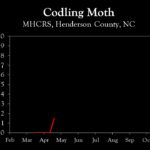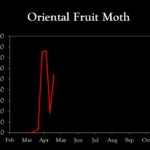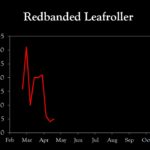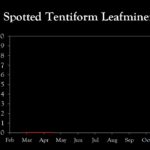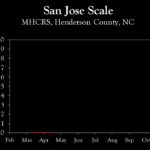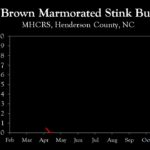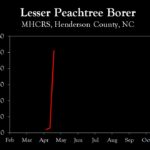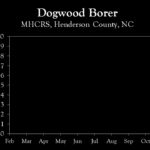WNC Orchard Insect Pest Populations – April 21, 2025
go.ncsu.edu/readext?1068787
en Español / em Português
El inglés es el idioma de control de esta página. En la medida en que haya algún conflicto entre la traducción al inglés y la traducción, el inglés prevalece.
Al hacer clic en el enlace de traducción se activa un servicio de traducción gratuito para convertir la página al español. Al igual que con cualquier traducción por Internet, la conversión no es sensible al contexto y puede que no traduzca el texto en su significado original. NC State Extension no garantiza la exactitud del texto traducido. Por favor, tenga en cuenta que algunas aplicaciones y/o servicios pueden no funcionar como se espera cuando se traducen.
Português
Inglês é o idioma de controle desta página. Na medida que haja algum conflito entre o texto original em Inglês e a tradução, o Inglês prevalece.
Ao clicar no link de tradução, um serviço gratuito de tradução será ativado para converter a página para o Português. Como em qualquer tradução pela internet, a conversão não é sensivel ao contexto e pode não ocorrer a tradução para o significado orginal. O serviço de Extensão da Carolina do Norte (NC State Extension) não garante a exatidão do texto traduzido. Por favor, observe que algumas funções ou serviços podem não funcionar como esperado após a tradução.
English
English is the controlling language of this page. To the extent there is any conflict between the English text and the translation, English controls.
Clicking on the translation link activates a free translation service to convert the page to Spanish. As with any Internet translation, the conversion is not context-sensitive and may not translate the text to its original meaning. NC State Extension does not guarantee the accuracy of the translated text. Please note that some applications and/or services may not function as expected when translated.
Collapse ▲ The majority of apples throughout the region are at petal fall, with some later cultivars still blooming. As discussed in last week’s update, plum curculio and oriental fruit moth are the key pests of concern (see table of insecticide options below). Also, for those that did not apply an insecticide targeting San Jose scale before bloom, a product effective against that insect should be made by First Cover.
The majority of apples throughout the region are at petal fall, with some later cultivars still blooming. As discussed in last week’s update, plum curculio and oriental fruit moth are the key pests of concern (see table of insecticide options below). Also, for those that did not apply an insecticide targeting San Jose scale before bloom, a product effective against that insect should be made by First Cover.
At the Mountain Horticultural Crops Research Station in Mills River, codling moth biofix occurred today (April 21). While we do not have traps off the mountain, biofix in Cleveland and Lincoln County is usually about 7 days before Henderson County, so for modeling purposes we have set biofix in those areas as April 14. Based on the weather forecast, It is anticipated that an initial insecticide application targeting codling moth (about 250 DD, early egg hatch) in the Cleveland/Lincoln County area will occur on April 29 or 30. In Henderson County, it will likely be another 2 weeks before codling moth egg hatch begins.
Relative Efficacy of Insecticides for Petal Fall
(─ no activity, 1 = least effective, 5 = most effective)
| Insecticide (active ingredient) | Plum curculio | Oriental fruit moth | Rosy apple aphid | San Jose scale | Toxicity to Bees |
| Actara (thiamethoxam) | 5 | 2 | 5 | ─ | Highly toxic |
| Assail (acetamiprid) | 3 | 4 | 5 | 4 | Moderately toxic |
| Belay (chlothianidin) | 4 | 3 | 5 | ─ | Highly toxic |
| Avaunt (Indoxacarb) | 4 | 4 | ─ | ─ | Highly toxic |
| Imidan (phosmet) | 4 | 4 | ─ | 1 | Highly toxic |
| Verdepryn (cyclaniliprole) | 4 | 5 | ─ | 3 | Highly toxic |
| Sevin (carbaryl) | 3 | 3 | ─ | 2 | Highly toxic |
| Voliam Flexi (thiamethoxam + chlorantraniliprole) | 5 | 5 | 5 | ─ | Highly toxic |
| Esteem (pyriproxyfen) | ─ | 4 | 2 | 5 | Slightly toxic |
| Centaur (buprofezin) | ─ | ─ | ─ | 5 | Slightly toxic |
| Movento (spirotetramat) | ─ | ─ | 5 | 4 | Moderately toxic |
Learn more about southeastern apple insect pests at the Apple Insect Management page.
2025 Average Weekly Trap Captures
| HENDERSON COUNTY | |||
| Insects per trap | |||
| Apr 7 | Apr 14 | Apr 21 | |
| Codling moth | 0.0 | 0.0 | 1.5 |
| Oriental fruit moth | 76.5 | 18.5 | 54.5 |
| Tufted apple bud moth | 0.0 | 1.0 | 20.0 |
| Redbanded leafroller | 6.0 | 4.0 | 5.0 |
| Obliquebanded leafroller | n/a | n/a | n/a |
| Lesser appleworm | n/a | n/a | n/a |
| Apple maggot (research orchards) | n/a | n/a | n/a |
| Apple maggot (abandoned orchard) | n/a | n/a | n/a |
| Brown marmorated stink bug (commercial) | n/a | n/a | n/a |
| Brown marmorated stink bug (unsprayed research orchard) | 0.5 | 0.0 | 0.0 |
| Spotted tentiform leafminer | 0.0 | 0.0 | 0.0 |
| Dogwood borer | n/a | n/a | 0.0 |
| Peachtree borer | n/a | n/a | n/a |
| Lesser peachtree borer | 2.0 | 3.0 | 51.0 |
| San Jose scale | 0.0 | 0.0 | 0.0 |
*Note that these averages illustrate only the timing of insect emergence and fluctuations in populations, and are not representative of population levels in any given orchard. The only way to have an accurate assessment of an individual orchard’s populations is to set up traps in that orchard.
2025 Accumulated Degree Days
| HENDERSON COUNTY | ||||
| Apr 7 | Apr 14 | Apr 21 | ||
| Codling moth (Biofix: April 21) | n/a | n/a | Biofix | |
| Oriental fruit moth (Biofix: March 17) | 263 | 304 | 413 | |
| Tufted apple bud moth (Biofix not yet reached) | n/a | n/a | n/a | |



